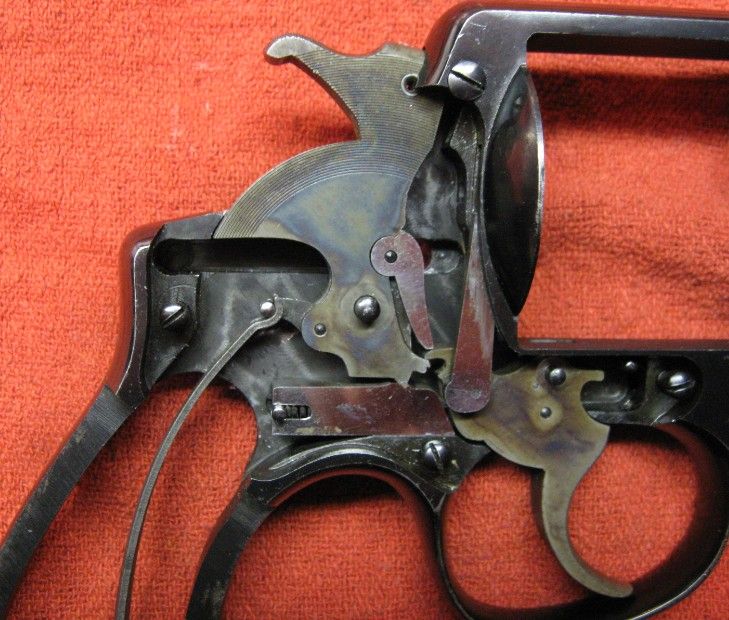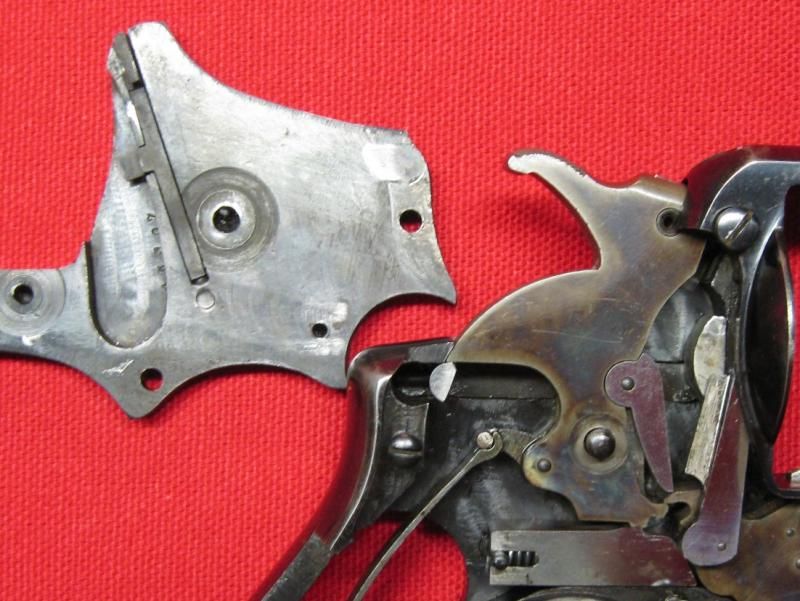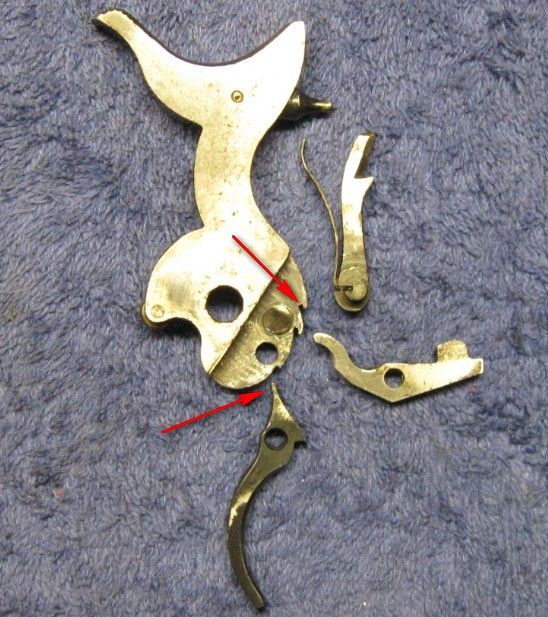
 |
|
|||||||
| Forum Rules | Firearms Safety | Firearms Photos | Links | Library | Lost Password | Email Changes |
| Register | FAQ | Calendar | Today's Posts | Search |
 |
|
|
Thread Tools | Search this Thread |
|
|
#26 |
|
Staff
Join Date: April 13, 2000
Location: Northern Virginia
Posts: 41,380
|
To be honest, I don't know.
I know both Colt and S&W were struggling to turn out as many guns as the Government was demanding (so much so that the military took over control of operations at S&W for the duration of the war)... Could the normal inspector approval process have been altered? Maybe... Or, were the inspector stamps put on prior to final finishing so that they would have a full finish bluing? Again, I don't know.
__________________
"The gift which I am sending you is called a dog, and is in fact the most precious and valuable possession of mankind" -Theodorus Gaza Baby Jesus cries when the fat redneck doesn't have military-grade firepower. |
|
|
|
|
#27 |
|
Member In Memoriam
Join Date: March 17, 1999
Posts: 24,383
|
I am not sure about the hammer block situation. Neither my S&W Model 1917 (939xx) nor my Brazilian contract model (1640xx) have hammer blocks of any kind, nor are the sideplates cut for them.
Further, the Brazilian gun has the U.S. eagle markings on the barrel and frame, indicating that it was not made as new. Reportedly, S&W bought back from the U.S. Army both parts and completed guns in order to fill the Brazilian contract, and my revolver supports that belief. (The Army took over S&W during WWI because of production delays, and at the end of the war seized all M1917's and parts as U.S. property, so S&W had no "leftover" 1917's or parts.) FWIW, all Model 1917 revolvers were shipped from the factories as blued. Both companies skipped final polishong, so the finish is often dull (some Colts are really rough looking) but they were all blue, not Parkerized. Parkerizing was done when the guns were taken from storage and refurbished during WWII. Jim |
|
|
|
|
#28 | |
|
Senior Member
Join Date: October 14, 2009
Location: Sunshine and Keystone States
Posts: 4,461
|
I posted the serial number discrepancy issue over at the Colt Forum and one of the regulars there looked it up in Charles Clawson's book. My gun was delivered to Springfield Armory on April 1st, 1918, making the manufacture date likely sometime in March.
 Addendum from coltforum.com (thanks and attribution to haggis) - Quote:
Last edited by spacecoast; September 9, 2014 at 01:09 AM. |
|
|
|
|
|
#29 |
|
Staff
Join Date: April 13, 2000
Location: Northern Virginia
Posts: 41,380
|
The leftover parts were those that Smith repurchased from the Gov. Apparently early Brazil Ian contract guns were made with some of those.
|
|
|
|
|
#30 |
|
Junior member
Join Date: January 1, 2007
Location: Idaho
Posts: 2,282
|
|
|
|
|
|
#31 |
|
Member In Memoriam
Join Date: March 17, 1999
Posts: 24,383
|
Might I ask those who own or have access to S&W Model 1917's to check and see if they have hammer blocks. I have examined several 1917's and am pretty well convinced that none had the block, but I would like a larger sample. There is no need to remove the sideplate; you can look in front of the hammer and watch the old "wing" block moving sideways in and out of the sideplate as the hammer is moved back and forward.
I note that the Brazilian contract revolver Driftwood shows is an ex-U.S. Army gun or at least frame. I wonder if it has a hammer block. IIRC, the GHS (Gilbert H. Stewart) mark indicates the gun was inspected at S&W. The later eagle inspection marks were applied at Springfield Armory; the completed guns were simply trucked across town. Jim |
|
|
|
|
#32 |
|
Staff
Join Date: April 13, 2000
Location: Northern Virginia
Posts: 41,380
|
I won't be home until the end of the week.
|
|
|
|
|
#33 |
|
Staff
Join Date: April 13, 2000
Location: Northern Virginia
Posts: 41,380
|
I had to make a quick trip home so I checked.
My Brazilian 1917 has the late style wing hammerblock. Mine is close to the end of the 1930s run so it is probably a newly manufactured frame. |
|
|
|
|
#34 |
|
Senior Member
Join Date: January 3, 2014
Location: Land of the Pilgrims
Posts: 2,033
|
Howdy
No hammer block in the 1918 vintage Model 1917. I took this photo of the guts when I had the side plate off a few months ago. If there had been a hammer block in the side plate I probably would have taken a photo of it. Besides, as you can see there is no 'ramp' on the hand to actuate a side plate mounted hammer block.  James K - you state that my Brazilian is an ex-army gun, or at least the frame is. Can you explain how you know that? I took a look and as far as I could tell I could not see a hammer block sliding away inside the frame. I may have to pop the side plate off to make sure. I have no shipping date on that one, I will have to look into that. Just so everybody knows what we are talking about, here is an M&P that shipped in 1939. It has the type of hammer block that is pressed into the side plate. In this photo you can see the hammer block pressed into a slot in the side plate, and you can see the 'ramp' on the pawl (hand) that activates the hammer block. As the pawl rides up, the ramp forces the hammer block back into the frame.  For what it's worth, this is the type of hammer block that failed in the famous incident in WWII where a Victory Model fell to the deck of a warship and discharged, killing a sailor. I believe I have read that upon investigation it appeared that cosmoline or some other type of grease bound up the hammer block and prevented it from functioning properly. Plus, who knows how far the gun fell? I read it fell from the superstructure of a warship and hit the deck. It may have fallen many feet. ************************** Now I have a question. According to the Standard Catalog of Smith and Wesson by Supica and Nahas: "The cylinder is heat treated for strength and is a fluted six shot having a nominal length of 1.55" with a square cut shoulder to allow the use of the rimless 45 ACP cartridge without the use of the half moon clips, when necessary, and is also head spaced to allow the use of the 45 Auto Rim cartridge." It does not say early cylinders were not heat treated, and it does not say later ones were. I infer from this statement that starting in 1917 the cylinders for this model were heat treated. Comments? |
|
|
|
|
#35 |
|
Staff
Join Date: April 13, 2000
Location: Northern Virginia
Posts: 41,380
|
Huh.
I'd always read that the cylinders for the 1917 were not heat treated because of the press of wartime necessities. I was going to post pictures of my Brazilian's sideplate, but Driftwood's pictures are far better than the quick cellphone snaps I took.
__________________
"The gift which I am sending you is called a dog, and is in fact the most precious and valuable possession of mankind" -Theodorus Gaza Baby Jesus cries when the fat redneck doesn't have military-grade firepower. |
|
|
|
|
#36 | |
|
Senior Member
Join Date: April 22, 2011
Posts: 322
|
Quote:
The number on the butt was applied at the arsenal and is the Government number. They serialized separately and the numbers do not match up to the manufacturer's serial #. |
|
|
|
|
|
#37 |
|
Member In Memoriam
Join Date: March 17, 1999
Posts: 24,383
|
That is partially correct. The Colt M1917 has two serial numbers; the one inside the crane is the serial number in the New Service series, sometimes called the "Colt serial number." The number on the butt is the "Army serial number". The former were not in series for the M1917, as Colt continued to make the New Service for commercial sales (Colt's commercial guns of that era had no butt serial numbers). The latter "Army" numbers are in series for the 1917 and are unique to that model.
Both markings were put on at the Colt factory, not at "the arsenal" or anywhere else. S&W assigned their M1917 a new number series, since they considered it a different model from other revolvers made on the same frame, so the butt serial number is the true factory and Army serial number, AFIAK, all S&W Model 1917 revolvers were delivered to Springfield Armory (in the same city, Springfield, MA) and distributed from there; Colt M1917's were shipped to whatever depot the Army directed, the same as Model 1911's. Jim |
|
|
|
|
#38 |
|
Junior member
Join Date: January 1, 2007
Location: Idaho
Posts: 2,282
|
I've owned Smiths for like a hundred years....OK, 43 years. Anyway isn't the hammer block redundant to the trigger spring guide thingy that keeps the hammer from going forward? I've been carrying my Brazilian contract with the hammer down on an empty chamber, but not sure why.
|
|
|
|
|
#39 |
|
Member In Memoriam
Join Date: March 17, 1999
Posts: 24,383
|
The rebound slide (the "thingy") and the hammer block safety have different purposes. In a swing cylinder revolver, it is necessary to have the hammer rebound after firing because if the hammer nose (firing pin) remains in the primer, the cylinder will be difficult or impossible to open. With a break top revolver, the cylinder is moving away from the firing pin in an arc, so a non-retracting firing pin is less of a problem.
That being the case, both S&W and Colt developed different ways to effect hammer rebound. S&W first used a rebound lever, powered by its own spring. In the 1905 design, that was replaced with the rebound slide as we know it today. It seems that S&W first thought the rebound slide would indeed serve as a hammer block safety. But they found out that two things could happen if the hammer were hit hard enough. Either the rebound slide, which is fairly thin, could be crushed, or the hammer stud (pin) could shear off. In either case, the gun would fire. So they developed a hammer block safety. Colt went basically the same route, finding that their rebound lever was not enough, and they developed their famous "positive safety". Unlike S&W's safety, which was spring powered, Colt's system worked off the trigger; if it wasn't engaged, the trigger could not move forward to engage the hammer for a shot. In the famous Navy incident, an S&W M&P discharged when dropped on the hammer and killed a sailor. Investigation showed that the spring-powered safety was stuck due to old grease and couldn't move out to block the hammer. It was a freak accident, but S&W redesigned its hammer block safety to be "positive" and independent of any separate spring. That system is in use today and like the Colt system, will prevent the trigger from engaging if the safety is not operating. Jim |
|
|
|
|
#40 |
|
Member In Memoriam
Join Date: March 17, 1999
Posts: 24,383
|
Hi, Driftwood,
My error on the Brazilian contract gun. I got confused and thought that GHS marking was on it, rather than on the US M1917. Jim |
|
|
|
|
#41 |
|
Junior member
Join Date: January 1, 2007
Location: Idaho
Posts: 2,282
|
Thank you James, I guess I have a five shooter.
|
|
|
|
|
#42 |
|
Senior Member
Join Date: March 1, 2000
Location: Boise, ID
Posts: 8,518
|
Parts and service for the Smith are more readily available than for the Colt.
If the gun is going to be a shooter, then the Smith would be the better choice. |
|
|
|
|
#43 |
|
Member In Memoriam
Join Date: March 17, 1999
Posts: 24,383
|
I sometimes think the danger is exaggerated; not many people drop their guns on a hard surface, only a fraction of those guns are loaded, and a still smaller fraction land in such a way as to discharge.
I would guess that the problem is greatest with SA revolvers, which tend to be "big boy's toys" and are used in fast draw, fanning, and so on, with (I would think) a greater likelihood of being mishandled. Still, safety must come first, and no one should ever suffer an injury or death due to a gun accident. So, I can't disagree with carrying an empty chamber under the hammer on a gun without a functioning hammer block safety. Jim |
|
|
|
|
#44 |
|
Senior Member
Join Date: July 26, 2006
Location: Southern Minnesota
Posts: 9,333
|
I have a Colt I bought a couple years ago... in a little worse shape than SPACE's... afterwards I ran across a guy that had a 5 gallon bucket full of new Autorim cases... mice had gotten in them, so some were stained & disposed of, but I had them coming out of my ears & sold them on my gun show table for the last couple years... I've gotten down on them now to enough for both guns ( my other is a Blackhawk with a custom 45 Autorim / ACP )
I'm not particularly attached to my 1917, other than it is my only Colt revolver...
__________________
In life you either make dust or eat dust... |
|
|
|
|
#45 | |
|
Senior Member
Join Date: May 26, 2012
Location: Weatherford, TX
Posts: 301
|
Quote:
__________________
A man can never have too much red wine, too many books, or too much ammunition -Rudyard Kipling |
|
|
|
|
|
#46 | |
|
Senior Member
Join Date: January 3, 2014
Location: Land of the Pilgrims
Posts: 2,033
|
Quote:
Single Action revolvers are a completely different story. The tip of the trigger and the lip of the so called 'safety notch' are much more fragile than the rebound slide in a S&W. All you have to do is look at the history. It was well known over 100 years ago that a Colt was not safe fully loaded with six rounds. That is exactly why so many revolver manufacturers went to rebounding hammers in the early part of the 20th Century. Iver Johnson even promoted the safety of their revolvers with their 'hammer the hammer' ad campaign. Look at how thin the sear is. It does not take much force to shear it completely off, and then the gun is almost guaranteed to fire if there is a live round under the hammer. Not just dropping the gun could cause it to fire, a stirrup inadvertently dropped on the hammer could do it too.  That's why Ruger completely redesigned the Blackhawk series and introduced the transfer bar in the 1970s. Just too much legal exposure. One of these days I mean to take an old Hand Ejector without a hammer block in it, load it up with a primed empty case, and do a series of drop tests to find out just how unsafe they are. Don't forget, that Victory Model freak shipboard accident does not say how far the gun fell. I'm betting it fell a lot farther than waist high. |
|
|
|
|
|
#47 |
|
Senior Member
Join Date: October 14, 2009
Location: Sunshine and Keystone States
Posts: 4,461
|
Driftwood - you've been posting some outstanding pictures lately, thanks for taking the time to do that.
|
|
|
|
|
#48 |
|
Member In Memoriam
Join Date: March 17, 1999
Posts: 24,383
|
A big second on that. Those are excellent pictures and show just what Driftwood is talking about.
Ruger's redesign was not just to reduce the legal exposure. After a man died when an old style Ruger fell and discharged, Ruger was sued for enough that if they had lost, the company would have been kaput. They reached a settlement which involved a cash outlay, plus putting on the "billboard" warning and redesigning their SA revolvers so they would be safe if dropped. There has been some flak from the extreme folks about both the warning and the redesign, but the choice was to accept those things or have Ruger go out of business. I for one am glad Sturm, Ruger is still around; the warning is a small price to pay and the new Ruger SA's really are better and safer than the old ones. Jim |
|
|
 |
|
|